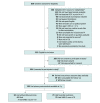Association of Blood-Based Brain Injury Biomarker Concentrations With Outcomes After Pediatric Cardiac Arrest
- PMID: 36074465
- PMCID: PMC9459665
- DOI: 10.1001/jamanetworkopen.2022.30518
Association of Blood-Based Brain Injury Biomarker Concentrations With Outcomes After Pediatric Cardiac Arrest
Abstract
Importance: Families and clinicians have limited validated tools available to assist in estimating long-term outcomes early after pediatric cardiac arrest. Blood-based brain-specific biomarkers may be helpful tools to aid in outcome assessment.
Objective: To analyze the association of blood-based brain injury biomarker concentrations with outcomes 1 year after pediatric cardiac arrest.
Design, setting, and participants: The Personalizing Outcomes After Child Cardiac Arrest multicenter prospective cohort study was conducted in pediatric intensive care units at 14 academic referral centers in the US between May 16, 2017, and August 19, 2020, with the primary investigators blinded to 1-year outcomes. The study included 120 children aged 48 hours to 17 years who were resuscitated after cardiac arrest, had pre-cardiac arrest Pediatric Cerebral Performance Category scores of 1 to 3 points, and were admitted to an intensive care unit after cardiac arrest.
Exposure: Cardiac arrest.
Main outcomes and measures: The primary outcome was an unfavorable outcome (death or survival with a Vineland Adaptive Behavior Scales, third edition, score of <70 points) at 1 year after cardiac arrest. Glial fibrillary acidic protein (GFAP), ubiquitin carboxyl-terminal esterase L1 (UCH-L1), neurofilament light (NfL), and tau concentrations were measured in blood samples from days 1 to 3 after cardiac arrest. Multivariate logistic regression and area under the receiver operating characteristic curve (AUROC) analyses were performed to examine the association of each biomarker with outcomes on days 1 to 3.
Results: Among 120 children with primary outcome data available, the median (IQR) age was 1.0 (0-8.5) year; 71 children (59.2%) were male. A total of 5 children (4.2%) were Asian, 19 (15.8%) were Black, 81 (67.5%) were White, and 15 (12.5%) were of unknown race; among 110 children with data on ethnicity, 11 (10.0%) were Hispanic, and 99 (90.0%) were non-Hispanic. Overall, 70 children (58.3%) had a favorable outcome, and 50 children (41.7%) had an unfavorable outcome, including 43 deaths. On days 1 to 3 after cardiac arrest, concentrations of all 4 measured biomarkers were higher in children with an unfavorable vs a favorable outcome at 1 year. After covariate adjustment, NfL concentrations on day 1 (adjusted odds ratio [aOR], 5.91; 95% CI, 1.82-19.19), day 2 (aOR, 11.88; 95% CI, 3.82-36.92), and day 3 (aOR, 10.22; 95% CI, 3.14-33.33); UCH-L1 concentrations on day 2 (aOR, 11.27; 95% CI, 3.00-42.36) and day 3 (aOR, 7.56; 95% CI, 2.11-27.09); GFAP concentrations on day 2 (aOR, 2.31; 95% CI, 1.19-4.48) and day 3 (aOR, 2.19; 95% CI, 1.19-4.03); and tau concentrations on day 1 (aOR, 2.44; 95% CI, 1.14-5.25), day 2 (aOR, 2.28; 95% CI, 1.31-3.97), and day 3 (aOR, 2.04; 95% CI, 1.16-3.57) were associated with an unfavorable outcome. The AUROC models were significantly higher with vs without the addition of NfL on day 2 (AUROC, 0.932 [95% CI, 0.877-0.987] vs 0.871 [95% CI, 0.793-0.949]; P = .02) and day 3 (AUROC, 0.921 [95% CI, 0.857-0.986] vs 0.870 [95% CI, 0.786-0.953]; P = .03).
Conclusions and relevance: In this cohort study, blood-based brain injury biomarkers, especially NfL, were associated with an unfavorable outcome at 1 year after pediatric cardiac arrest. Additional evaluation of the accuracy of the association between biomarkers and neurodevelopmental outcomes beyond 1 year is needed.
Conflict of interest statement
Figures


References
-
- Atkins DL, Everson-Stewart S, Sears GK, et al. ; Resuscitation Outcomes Consortium Investigators . Epidemiology and outcomes from out-of-hospital cardiac arrest in children: the Resuscitation Outcomes Consortium Epistry–Cardiac Arrest. Circulation. 2009;119(11):1484-1491. doi:10.1161/CIRCULATIONAHA.108.802678 - DOI - PMC - PubMed
-
- Geocadin RG, Callaway CW, Fink EL, et al. ; American Heart Association Emergency Cardiovascular Care Committee . Standards for studies of neurological prognostication in comatose survivors of cardiac arrest: a scientific statement from the American Heart Association. Circulation. 2019;140(9):e517-e542. doi:10.1161/CIR.0000000000000702 - DOI - PubMed
Publication types
MeSH terms
Substances
Grants and funding
LinkOut - more resources
Full Text Sources
Medical
Miscellaneous

